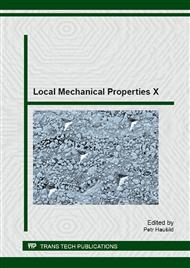p.53
p.61
p.65
p.69
p.73
p.77
p.81
p.87
p.91
Numerical Model of Instrumented Indentation by a Rounded Cone Indenter Using Finite Element Method
Abstract:
The paper serves as an introduction to investigation of mechanical properties of functionally graded materials and deals with elastic nanoindentation numerical models. The models were based on the finite element method. Young's moduli were estimated by Oliver-Pharr method. The indenter geometry for which numerical solutions were accomplished was a rounded cone indenter. The effect of tip sharpness was examined by applying an increasing spherical tip radius. The results show that the apparent Young's modulus and the hardness increase linearly with increasing radius of the tip. The effect of approaching interface between two elastic materials on the apparent hardness and indentation modulus was identified in 3D model. The specimen consisted of two materials. First, the interface was linear and parallel to the direction of indentation, so that the Young's modulus changed suddenly. Second, the Young's modulus was continuously changing. The dependence on various boundary conditions of the specimen was also considered.
Info:
Periodical:
Pages:
73-76
Citation:
Online since:
March 2014
Authors:
Price:
Сopyright:
© 2014 Trans Tech Publications Ltd. All Rights Reserved
Share:
Citation:


